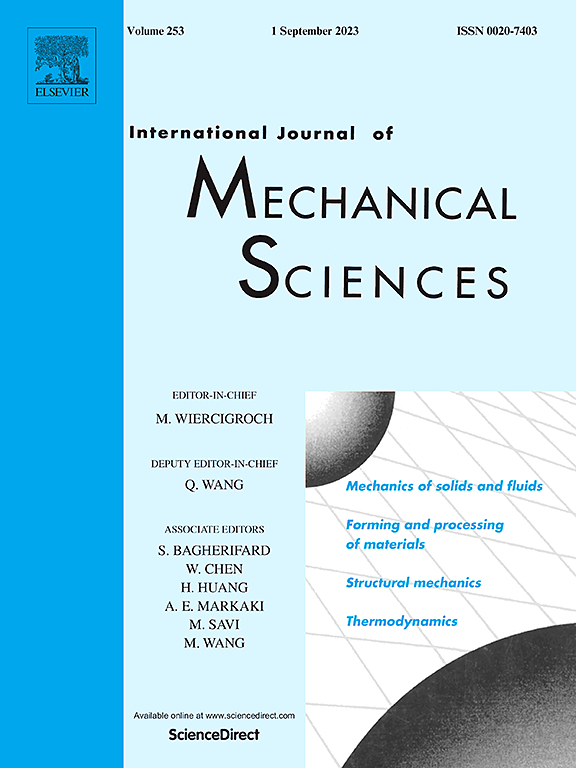Resilient multi-layered lattices with alternating chirality for self-recovering energy absorption
IF 7.1
1区 工程技术
Q1 ENGINEERING, MECHANICAL
International Journal of Mechanical Sciences
Pub Date : 2025-01-31
DOI:10.1016/j.ijmecsci.2025.110023
引用次数: 0
Abstract
This research focuses on the development of a high-performance metamaterial that combines dissipation and resilience, a subject of growing actual interest in vibration and impact mechanics as part of the quest for avant-garde self-recovering materials. In this context, a high-performance resilient layered metamaterial with alternating chiral topology is conceived and analyzed. Specifically, the single layer is realized via the periodic assembly of rigid disks connected by elastic ligaments and stacked using passing pins. The metadevice is formed by stacking layers with alternating chirality. This configuration induces relative rotations between the aligned discs in contact when in-plane forces are applied. Frictional dilating interfaces between adjacent disks produce a dissipative and resilient mechanical response, returning to the initial configuration at the end of the unloading phase. Specifically, the dissipative mechanism is designed to significantly attenuate vibratory motions and/or absorb energy during impact processes, while being reusable after the dynamic actions have acted on the metamaterial. This cutting-edge metamaterial offers several advantages over current technologies: i) hysteretic response with maximum dissipation of mechanical energy and high stiffness; ii) reuse of the device without external interventions, restoring the initial configuration at the end of the dynamic process; iii) multi-directional dissipative response; and iv) bilateral response, providing equal performance under both traction and compression.

求助全文
约1分钟内获得全文
求助全文
来源期刊

International Journal of Mechanical Sciences
工程技术-工程:机械
CiteScore
12.80
自引率
17.80%
发文量
769
审稿时长
19 days
期刊介绍:
The International Journal of Mechanical Sciences (IJMS) serves as a global platform for the publication and dissemination of original research that contributes to a deeper scientific understanding of the fundamental disciplines within mechanical, civil, and material engineering.
The primary focus of IJMS is to showcase innovative and ground-breaking work that utilizes analytical and computational modeling techniques, such as Finite Element Method (FEM), Boundary Element Method (BEM), and mesh-free methods, among others. These modeling methods are applied to diverse fields including rigid-body mechanics (e.g., dynamics, vibration, stability), structural mechanics, metal forming, advanced materials (e.g., metals, composites, cellular, smart) behavior and applications, impact mechanics, strain localization, and other nonlinear effects (e.g., large deflections, plasticity, fracture).
Additionally, IJMS covers the realms of fluid mechanics (both external and internal flows), tribology, thermodynamics, and materials processing. These subjects collectively form the core of the journal's content.
In summary, IJMS provides a prestigious platform for researchers to present their original contributions, shedding light on analytical and computational modeling methods in various areas of mechanical engineering, as well as exploring the behavior and application of advanced materials, fluid mechanics, thermodynamics, and materials processing.
 求助内容:
求助内容: 应助结果提醒方式:
应助结果提醒方式:


